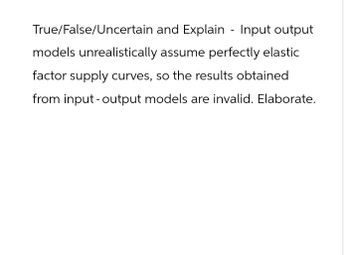
ENGR.ECONOMIC ANALYSIS
14th Edition
ISBN: 9780190931919
Author: NEWNAN
Publisher: Oxford University Press
expand_more
expand_more
format_list_bulleted
Question

Transcribed Image Text:True/False/Uncertain
and Explain Input output
models unrealistically assume perfectly elastic
factor supply curves, so the results obtained
from input-output models are invalid. Elaborate.
Expert Solution
This question has been solved!
Explore an expertly crafted, step-by-step solution for a thorough understanding of key concepts.
This is a popular solution
Trending nowThis is a popular solution!
Step by stepSolved in 4 steps

Knowledge Booster
Learn more about
Need a deep-dive on the concept behind this application? Look no further. Learn more about this topic, economics and related others by exploring similar questions and additional content below.Similar questions
- Please explain both true and false When a firm's resources are not specialized, its production possibility frontier (PPF) is a straight, downward sloping line. True or False Note:- Do not provide handwritten solution. Maintain accuracy and quality in your answer. Take care of plagiarism.Answer completely.You will get up vote for sure.arrow_forwardGiven the production function, Y = AK "L(¹-a) assume that a = 1/3. The labor supply equation is LS = 60*w - R In TABLE ONE, each column represents a labor market in medium-run equilibrium. In column two, an increase in on-the-job-search (OJS) has shifted labor supply to the right. In column three, workers' awareness of higher productivity has shifted labor supply back to the left. 1. Complete TABLE ONE. [Round w to two decimal places.] W = 2/3Y L TABLE ONE Y A K L W R (u) 1 (a) (b) 6000 398 8.23 (c) 21 2 5444 (d) 6000 (e) 8.54 70 (u) = Bw-L-R 3 5.3 6000 415 (h) 75 (1)arrow_forwardYou hired a mathematician (who never took a Natural Resource Economics class) to solve a 4 period nonrenewable resource problem assuming a competitive industry and a total resource constraint of 100. He returns an answer to you where per period output levels are increasing and he gets a lambda value: 1 = -3.45. From this you conclude: Demand is too low for the constraint of 100 to be binding. Therefore there is no scarcity. The mathematician must have made a mathematical mistake. Competitive firms place no weight on the future and therefore behave like there is no opportunity cost of extracting a resource today. Demand is too high to support the extraction of the resource so the marginal user cost become negative.arrow_forward
- Dynamic efficiency refers to an allocation such that no further shuffling of extraction across periods will increase the sum of the present discounted values of the firm’s stream of future profits. If there are just two periods in the story, explain why the allocation of a scarce exhaustible resource that maximizes the present discounted value of profits across two periods will involve more extraction in the first period and less extraction in the second period, rather than an equal amount in both periods.arrow_forwardSolve the attachment.arrow_forwardQuestion Labour is a variable input into the production process. In this sense, a change in the amount of labour used in production (the number of employee hours) lead to a proportionate change in labour costs. However, some other labour-related costs may also occur. a) Define "quasi-fixed costs" and give three examples of them. b) Assume a t-period of setting. Write down the mathematical expression that describes the profit-maximizing employment rule of a firm when there exist quasi-fixed costs. Explain what this expression means. c) Consider a firm that only exists for one period. The value of labour's (L) marginal product is given by VMP₁ = P × MP₁, where P is the price of output, and MPL = 10 0.5L. The wage rate is $10. Assume that there are no hiring or training costs. If the firm expects the price of output to be $10, what is the optimal level of employment? If the firm hires these workers, but then finds out that the price of output is $5, what will the firm do? Hint: If there…arrow_forward
arrow_back_ios
arrow_forward_ios
Recommended textbooks for you

 Principles of Economics (12th Edition)EconomicsISBN:9780134078779Author:Karl E. Case, Ray C. Fair, Sharon E. OsterPublisher:PEARSON
Principles of Economics (12th Edition)EconomicsISBN:9780134078779Author:Karl E. Case, Ray C. Fair, Sharon E. OsterPublisher:PEARSON Engineering Economy (17th Edition)EconomicsISBN:9780134870069Author:William G. Sullivan, Elin M. Wicks, C. Patrick KoellingPublisher:PEARSON
Engineering Economy (17th Edition)EconomicsISBN:9780134870069Author:William G. Sullivan, Elin M. Wicks, C. Patrick KoellingPublisher:PEARSON Principles of Economics (MindTap Course List)EconomicsISBN:9781305585126Author:N. Gregory MankiwPublisher:Cengage Learning
Principles of Economics (MindTap Course List)EconomicsISBN:9781305585126Author:N. Gregory MankiwPublisher:Cengage Learning Managerial Economics: A Problem Solving ApproachEconomicsISBN:9781337106665Author:Luke M. Froeb, Brian T. McCann, Michael R. Ward, Mike ShorPublisher:Cengage Learning
Managerial Economics: A Problem Solving ApproachEconomicsISBN:9781337106665Author:Luke M. Froeb, Brian T. McCann, Michael R. Ward, Mike ShorPublisher:Cengage Learning Managerial Economics & Business Strategy (Mcgraw-...EconomicsISBN:9781259290619Author:Michael Baye, Jeff PrincePublisher:McGraw-Hill Education
Managerial Economics & Business Strategy (Mcgraw-...EconomicsISBN:9781259290619Author:Michael Baye, Jeff PrincePublisher:McGraw-Hill Education


Principles of Economics (12th Edition)
Economics
ISBN:9780134078779
Author:Karl E. Case, Ray C. Fair, Sharon E. Oster
Publisher:PEARSON

Engineering Economy (17th Edition)
Economics
ISBN:9780134870069
Author:William G. Sullivan, Elin M. Wicks, C. Patrick Koelling
Publisher:PEARSON

Principles of Economics (MindTap Course List)
Economics
ISBN:9781305585126
Author:N. Gregory Mankiw
Publisher:Cengage Learning

Managerial Economics: A Problem Solving Approach
Economics
ISBN:9781337106665
Author:Luke M. Froeb, Brian T. McCann, Michael R. Ward, Mike Shor
Publisher:Cengage Learning

Managerial Economics & Business Strategy (Mcgraw-...
Economics
ISBN:9781259290619
Author:Michael Baye, Jeff Prince
Publisher:McGraw-Hill Education